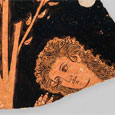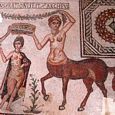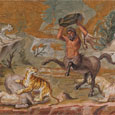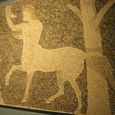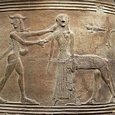KENTAURIDES
Greek Name
Κενταυρις Κενταυριδες
Transliteration
Kentauris, Kentaurides
Latin Spelling
Centauris, Centaurides
Translation
Female-Centaurs
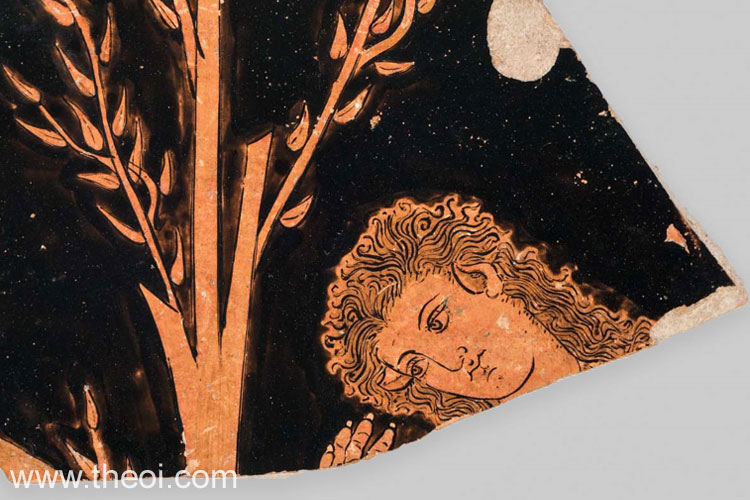
THE KENTAURIDES (Centaurides) were the female members of the Kentauroi (Centaur) tribe, creatures with the double-formed bodies of horses and men.
Female centaurs are seldom mentioned in ancient literature, although they do occasionally appear in ancient Greek paintings and Roman-era mosaics and reliefs. One Roman relief, housed in the Louvre Museum, depicts a Kentauris with infant in the train of the god Dionysos.
PARENTS
Presumably IXION & NEPHELE, though nowhere stated
NAMES
HYLONOME (Ovid Metamorphoses 12.394)
CLASSICAL LITERATURE QUOTES
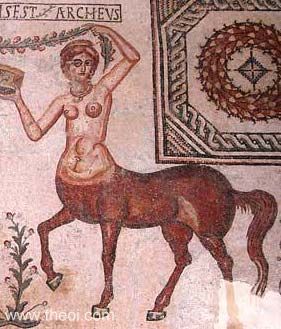
Philostratus the Elder, Imagines 2. 3 (trans. Fairbanks) (Greek rhetorician C3rd
A.D.) :
"[Ostensibly a description of an ancient Greek painting at Neapolis (Naples) :] Kentaurides (Centaurides).
You used to think that the race of Kentauroi (Centaurs) sprang from trees and rocks or, by Zeus, just from
mares--the mares which, men say, [Kentauros (Centaurus)] the son of Ixion covered, the man by whom the Kentauroi
though single creatures came to have their double nature. But after all they have, as we see, mothers of the
same stock and wives next and colts as their offspring and a most delightful home; for I think you would not
grow weary of Pelion and the life there and its wind-nurtured growth of ash which furnishes spear-shafts that
are straight and at the same time do not break at the spearhead. And its caves are most beautiful and the
springs and the Kentaurides beside them, like Naides (Naiads) if we overlook the horse part of them, or like
[horse-riding] Amazones if we consider them along with their horse bodies; for the delicacy of their female form
gains in strength when the horse is seen in union with it. Of the baby Kentauroi here some lie wrapped in
swaddling clothes, some have discarded their swaddling clothes, some seem to be crying, some are happy and smile
as they suck flowing breasts, some gambol beneath their mothers while others embrace them when they kneel down,
and one is throwing a stone at his mother, for already he grows wanton. The bodies of the infants have not yet
taken on their definite shape, seeing that abundant milk is still their nourishment, but some that already are
leaping about show a little shagginess, and have sprouted mane and hoofs, though these are still tender.
How beautiful the Kentaurides are, even where they are horses; for some grow out of white mares, others are
attached to chestnut mares, and the coat's of others are dappled, but they glisten like those of horses that are
well cared for. There is also a white female Kentauroi that grows out of a black mare, and the very opposition
of the colours helps to produce the united beauty of the whole."
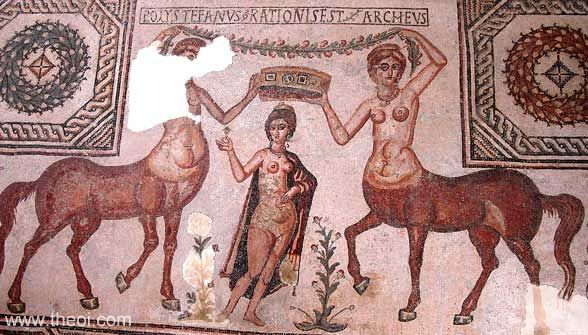
Ovid, Metamorphoses 12. 210 ff (trans. Melville) (Roman epic C1st B.C. to C1st A.D.)
:
"[During the battle between the Centaurs and the Lapiths of Thessaly :] Nor did his beauty ransom [the
centaur] Cyllarus, fighting that day, if hybrids such as he be granted beauty. His beard was just beginning, a
golden beard, and golden tresses fell down on his shoulders reaching to his flanks. High-mettled grace shone in
his face; his neck, chest, shoulders, hands and every manly part seemed like a sculptor's much-praised
masterpiece. Unblemished too his equine shape, nor less fine than his man's. With horse's head and neck he's
make fit mount for Castor, so high stood his chest-muscles, so rideable his back. Jet black he was, the whole of
him, save that his tail was white and legs were milk-white too. Many a centauress would be his mate, but one had
gained his heart, [the female centaur] Hylonome. In the high woods there was none comelier of all the
centaur-girls, and she alone by love and love's sweet words and winning ways held Cyllarus, yes, and the care
she took to look her best (so far as that may be with limbs like that). She combed her glossy hair, and twined
her curls in turn with rosemary or violets or roses, and sometimes she wore a pure white lily. Twice a day she
bathed her face in the clear brook that fell from Pagasae's high forest, twice she plunged her body in its flow,
nor would she wear on her left side and shoulder any skin but what became her from best-chosen beasts. Their
love was equal; on the hills they roamed together, and together they would go back to their cave; and this time
too they went into the Lapithae's palace side by side and side by side were fighting in the fray. A javelin (no
knowing from whose hand) came from the left and wounded Cyllarus, landing below the place where the chest joins
neck--slight wound, but when the point was pulled away, cold grew his damaged heart and cold his limbs. Hylonome
embraced him as he died, caressed the wound and, putting lips to lips, she tried to stay his spirit as it fled.
And when she saw him lifeless, she moaned words that in that uproar failed to reach my ears; and fell upon the
spear that pierced her love, and, dying, held her husband in her arms."
ANCIENT GREEK & ROMAN ART
SOURCES
GREEK
- Philostratus the Elder, Imagines - Greek Rhetoric C3rd A.D.
ROMAN
- Ovid, Metamorphoses - Latin Epic C1st B.C. - C1st A.D.
BIBLIOGRAPHY
A complete bibliography of the translations quoted on this page.
